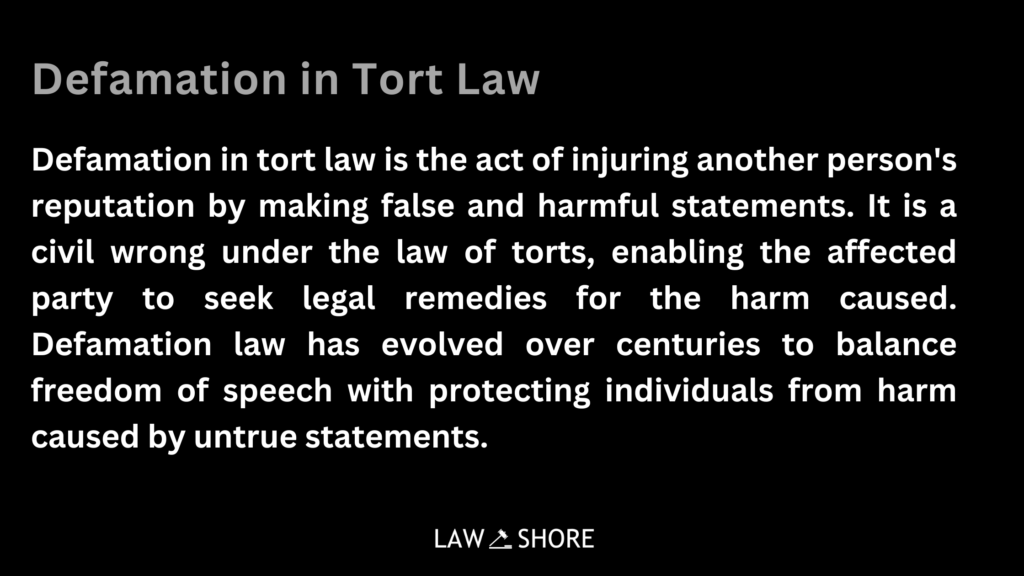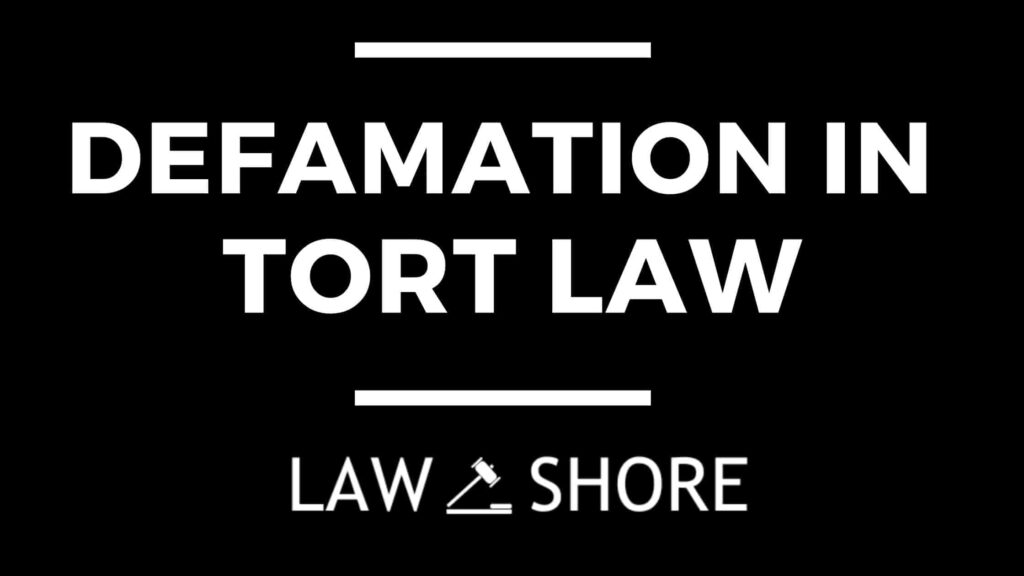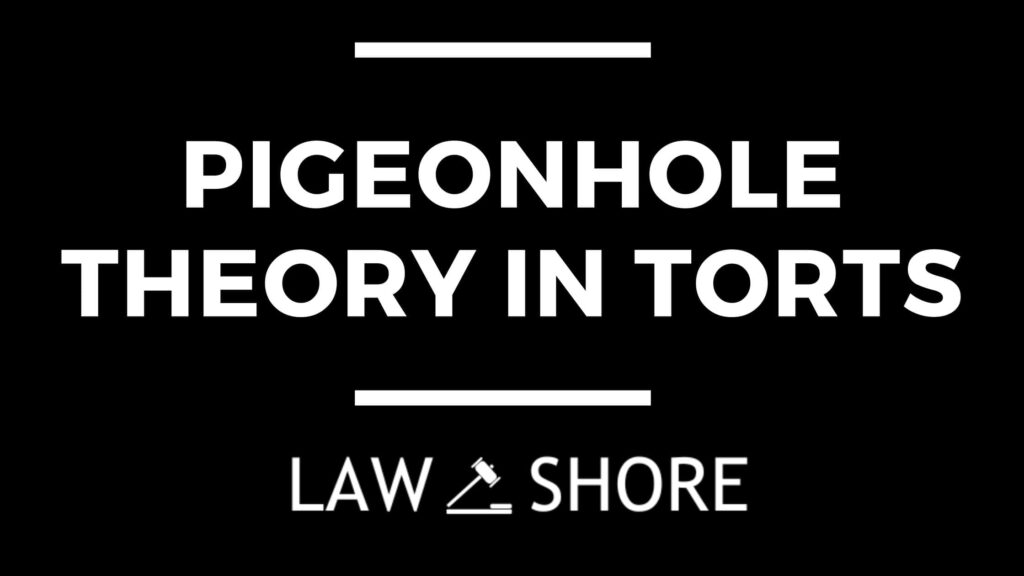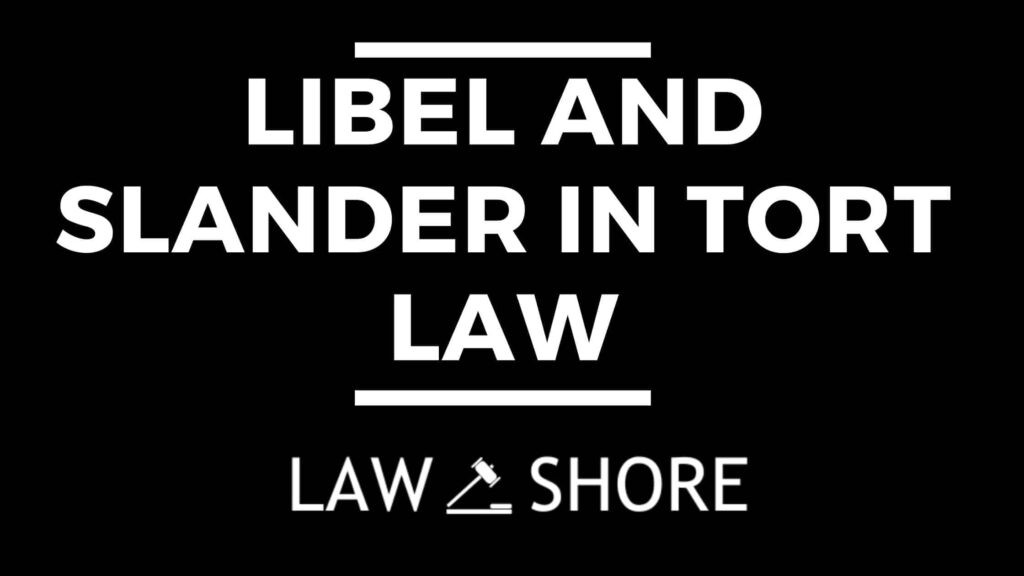Defamation in Tort Law
Table of Contents
ToggleDefamation in tort law is the act of injuring another person’s reputation by making false and harmful statements. It is a civil wrong under the law of torts, enabling the affected party to seek legal remedies for the harm caused. Defamation law has evolved over centuries to balance freedom of speech with protecting individuals from harm caused by untrue statements.
This article examines the key elements of defamation in Tort Law, its types (libel and slander), defences to defamation claims, and explores some real-world examples to illustrate how the law is applied, including the landmark case Donoghue v. Stevenson case, which shaped the understanding of tortious liability and negligence in English law.

Meaning
Defamation in Tort Law is the act of making false statements about an individual or entity that damage their reputation. It occurs when someone communicates a false statement to others, which lowers the reputation of the person in the eyes of society. The key element of defamation is that the statement must be false; truth is a complete defence in defamation cases. For a statement to be considered defamatory, it must harm the individual’s reputation by portraying them negatively, either by suggesting that they are involved in criminal or immoral activities or otherwise damaging their public image.
Additionally, the defamatory statement must be communicated to someone other than the person being defamed—whether through spoken words (slander) or written/published material (libel). Finally, the statement must clearly refer to the person or entity being defamed, meaning it must be identifiable to the person concerned. Defamation is considered a tort, and the injured party may seek legal redress, including compensation for harm caused to their reputation, personal relationships, or emotional well-being.
Key Elements of Defamation in Tort Law
False Statement
For a statement to be defamatory, it must be factually false. If the statement is true, even if it harms the person’s reputation, it cannot be considered defamatory, because truth is an absolute defence in defamation cases.
Example:
- Suppose a person, John, accuses a fellow employee, Mark, of stealing office supplies. If it turns out that Mark did indeed steal the supplies, the statement is true and thus cannot be classified as defamatory. The truth of the accusation invalidates any claim of defamation, regardless of the harm it causes Mark’s reputation.
- On the other hand, if John falsely accuses Mark of stealing when he did not, then the statement is false and defamatory. Mark can then pursue a defamation claim, since the statement is damaging to his reputation and is untrue.
Key Point: Truth is a complete defence to defamation, but the burden of proving the statement is true lies on the defendant.
Harms Reputation
The defamatory statement must lower the reputation of the person in the eyes of a “right-thinking” or average person in society. A statement does not need to cause actual loss of business or personal relationships, but it must tend to harm the individual’s standing or respectability in the community.
The harm is presumed if the statement is inherently damaging or offensive, such as calling someone a thief, a cheat, or a criminal.
Example:
- If a person, Sarah, spreads a rumor that her neighbor, Anna, is a child abuser, this statement would likely damage Anna’s reputation in the community. Even if Anna is never formally charged with any crime, her reputation could suffer as others may start viewing her with suspicion.
- Another example is when a company falsely accuses an employee of embezzlement. Even if the accusation does not lead to criminal charges, the employee’s reputation within the workplace is harmed as colleagues may distrust or avoid them, affecting their personal and professional relationships.
Key Point: It’s not necessary for the person to lose a specific job or income immediately, but the statement must damage their standing in the eyes of others.
Communicated to a Third Party (Publication)
For a statement to be defamatory, it must be published or communicated to a third party. This means the statement must be conveyed to someone other than the person being defamed. The third party need not be a large audience; a private conversation between two people is sufficient. The key here is that the statement must reach someone who could be influenced by it.
- Example:
If an individual, Jack, tells a close friend, Emma, that their mutual friend, Lisa, is having an affair, and this conversation is heard by a third person, the statement is considered “published.” Even though Jack and Emma had a private conversation, the fact that the statement was overheard by another person means the statement was communicated to a third party. - A case in which a defamatory statement was not published would be if someone tells a defamatory lie to another person in private, without anyone else overhearing or knowing. In such a case, no defamation claim can arise, because it was not communicated to a third party.
Key Point: The publication element refers to making the defamatory statement known to others, and even a private conversation where the defamation is shared with another person can suffice.
Identifiability
The defamatory statement must clearly refer to the person claiming to have been defamed. The individual must be identifiable, either by name or by the circumstances surrounding the statement. The person does not need to be specifically named, but it must be evident to a reasonable person that the statement is about them. This is critical, as the defendant must have known or should have reasonably known that the statement was referring to the plaintiff.
Example:
- If a newspaper publishes an article stating, “The CEO of a prominent tech company was caught in a corruption scandal,” and the CEO is not named but is widely known in the tech industry, the CEO might be able to claim defamation. Even though the person wasn’t explicitly named, they can argue that the description identifies them, and it would be reasonable for people in the industry to believe the statement was about them.
- However, if someone is generalizing about “all the politicians in this town” without specifying anyone, a defamation claim would fail, because it would not be clear that the statement is referring to a particular individual. In this case, there’s no identifiable person being defamed.
Key Point: The key is whether the statement can be reasonably understood to refer to the person claiming defamation in Tort Law.
Types of Defamation in Tort Law
There are two types of defamation i.e. Libel and Slander –
- Libel involves defamatory statements made in a permanent form, such as written words, photographs, or broadcasts. It is considered more serious because the statement endures over time and can reach a wider audience. Examples include defamatory newspaper articles or TV broadcasts. Libel is often easier to prove due to its permanence, and its harm to reputation is generally presumed.
- Slander, on the other hand, refers to defamatory statements made in a transient form, like spoken words, gestures, or sounds. It is typically less serious because it is fleeting and has a smaller, more immediate audience. Examples include defamatory comments made in a conversation or a public speech. Proof of harm in slander cases is often more difficult, as the statement may not be recorded, and actual damage to reputation must be shown.
- Innuendo – Innuendo in the context of defamation refers to a statement or remark that, while not directly defamatory on its face, becomes defamatory when considered in the context or in the light of additional facts or knowledge. It relies on the implication of a defamatory meaning that isn’t explicitly stated but can be inferred by the audience. Essentially, innuendo is a suggestion or indirect insinuation that can harm someone’s reputation.
Difference Between Defamation and Innuendo
While both defamation and innuendo deal with harm to a person’s reputation, the key difference lies in how the defamatory message is communicated and interpreted.
- Defamation: Refers to a direct statement or allegation that is false and harms an individual’s reputation. A defamatory statement is explicit, and it is immediately clear to any reasonable person that the statement is harmful.
- Innuendo: Refers to a suggestive or indirect statement, which may not be defamatory on its own but becomes defamatory when understood in context. It relies on the audience’s ability to interpret the hidden or implied meaning.
Illustrations of Defamation and Innuendo
1. Defamation Example:
- Suppose a newspaper article states: “John Doe has been arrested for embezzling funds from his company.” This is a direct, explicit statement accusing John Doe of committing a crime. It is defamatory because it falsely asserts that John has committed a criminal act, which harms his reputation. Even without additional context, the statement on its face is defamatory.
2. Innuendo Example:
- A person says: “I saw John walking out of the bank late at night, just before the company reported a large financial loss.” On the surface, this statement doesn’t directly accuse John of any wrongdoing. However, the innuendo arises when the audience connects the dots—based on the context that John is the company’s financial officer, the late-night visit to the bank could imply that he is involved in the financial loss or even a crime like embezzlement. Here, the defamatory meaning is not directly expressed but is inferred by the audience based on their knowledge of the situation.
Key Differences Between Defamation and Innuendo
Aspect | Defamation | Innuendo |
|---|---|---|
Nature of Statement | Direct, clear, and explicit statement. | Indirect, implied, or suggestive statement. |
Interpretation | Easily understood by any reasonable person. | Requires context or extra knowledge to be understood as defamatory. |
Clarity | The defamatory meaning is apparent immediately. | The defamatory meaning is hidden or subtle, depending on context. |
Example | “John Doe is a criminal.” | “I saw John walking near the jailhouse after hours.” (suggesting criminal behavior without direct accusation) |
Legal Impact | Defamation can be established easily. | Innuendo requires proving that the defamatory meaning is understood by the audience. |
Elements of a Defamation Claim
To establish a claim of defamation, the plaintiff must generally prove the following elements:
- Publication: The defamatory statement must have been communicated to a third party.
- Falsity: The statement must be false.
- Defamation: The statement must have damaged the reputation of the individual.
- Fault: Depending on the jurisdiction, the plaintiff may need to prove that the defendant acted with fault, which could include negligence or actual malice (especially in the case of public figures).
Reputation and Injury
Defamation in Tort Law focuses on the protection of reputation. A person’s reputation is viewed as their standing in society or the opinion held of them by others. Harm occurs when a defamatory statement reduces the esteem in which the individual is held.
Burden of Proof
In defamation claims, the burden of proof typically lies with the plaintiff. The plaintiff must prove the falsity of the statement and the damage to their reputation. In some cases, if the statement is defamatory on its face (per se), harm to reputation may be presumed.
Defences to Defamation in Tort Law
There are several defences available to defendants in defamation cases, including:
- Truth (Justification)
If the statement made is true, it cannot be defamatory. The defendant can argue that the statement is an accurate reflection of facts, which is an absolute defence. - Fair Comment
This defence protects statements made as an expression of opinion on matters of public interest. For example, a critic’s review of a movie or a journalist’s opinion about a political figure is protected as long as it is made in good faith and based on facts. - Privilege
Certain statements are considered privileged, and no defamation can be claimed. These include:
Absolute Privilege: Certain statements made in judicial proceedings or by lawmakers in the course of their duties are immune from defamation suits.
Qualified Privilege: Statements made in good faith for the protection of a legitimate interest, such as references to someone’s qualifications in an employment reference, may be privileged. - Consent
If the plaintiff consented to the publication of the statement, the defendant cannot be held liable for defamation. This can be an explicit or implied consent. - Innocent Dissemination
If the defendant merely disseminates a defamatory statement without knowing its defamatory nature, such as a publisher or distributor of books, the defendant may not be liable.
CASE LAWS
New York Times Co. v. Sullivan (1964)
This landmark case in the U.S. is critical in understanding defamation law, particularly in regard to public figures. The Supreme Court ruled that in defamation cases involving public officials or public figures, the plaintiff must prove “actual malice”—that the statement was made with knowledge of its falsity or with reckless disregard for the truth. This case is significant for balancing freedom of speech and protection of reputation, influencing how defamation cases are viewed in the context of public discourse.
Sim v. Stretch (1936)
In Sim v. Stretch, the court addressed the issue of whether a statement was defamatory. The case involved a claim made against a journalist who had written a statement suggesting that the plaintiff was a homosexual. The court found that the statement was defamatory as it lowered the reputation of the plaintiff in the eyes of right-thinking members of society. This case solidified that defamation in Tort Law could be based on any statement that lowers a person’s reputation, even if it is not specifically false in the sense of being an outright lie.
McManus v. Beckham (2004)
This case involved a claim for defamation in which the claimant, a celebrity, sued a tabloid newspaper for publishing false claims about their personal life. The court ruled in favour of the claimant, affirming that publication in any form that falsely harms someone’s reputation, including sensationalist tabloid stories, is actionable under defamation law. This case reinforced the idea that defamation in Tort Law can occur through any permanent publication that damages an individual’s reputation.
Loutchansky v. Times Newspapers Ltd. (2002)
In this case, the claimant, a Russian businessman, sued a newspaper for defamation over articles that accused him of being involved in organized crime. The court ruled in favour of the claimant, emphasizing that defamatory statements made without sufficient evidence or without an attempt to verify the truth are actionable. This case further developed the principle that publishers must take reasonable steps to verify the truth of potentially defamatory statements before publishing them.
Chase v. News Group Newspapers Ltd. (2002)
This case involved a defamation claim where the claimant, a former professional footballer, sued a newspaper for publishing false allegations about his personal life. The court ruled in favor of the claimant and emphasized the importance of protecting an individual’s reputation, especially when the statement was widely published. The case reinforced that even public figures have the right to protect their reputation from defamatory attacks, provided they can prove the falsity of the statement.
Gatley v. The Times Newspapers Ltd. (2016)
This is a recent and significant defamation case in which the claimant, an individual falsely accused of serious criminal behavior, successfully sued for defamation. The court ruled in favour of the claimant, citing that the defamatory content, which had been published across multiple media platforms, harmed his reputation significantly. This case emphasized the evolving nature of defamation claims in the digital age, particularly regarding online publications and social media platforms.
K.K. Verma v. Union of India (1954)
In this case, the plaintiff filed a defamation suit against the Union of India after a newspaper published a defamatory article accusing him of dishonest and corrupt practices in his professional life. The court ruled that defamation in Tort Law does not necessarily require an overt falsehood but can arise when a statement lowers the reputation of an individual in the eyes of the public, even through implied suggestions. The case reinforced the point that defamation in Tort Law damages a person’s reputation, even if the words are not explicitly harmful but can be inferred to have a damaging meaning.
Conclusion
Defamation in Tort Law is a critical tort that seeks to balance individual reputation with freedom of speech. As we have seen, it is essential for a claimant to prove the elements of defamation: publication, falsity, harm, and fault. Various defences exist, but a careful balance must be maintained to protect reputations without stifling free expression. As society increasingly relies on digital platforms for communication, defamation law continues to evolve to address new challenges, particularly in the realm of online defamation.
Defamation in Tort Law seeks to protect individuals from false statements that unjustly harm their reputation. By meeting the elements outlined above, the law helps ensure that individuals are not wrongfully stigmatized based on untrue or damaging information. Understanding these key elements—falsity, harm to reputation, publication to a third party, and identifiability—is essential for both plaintiffs and defendants in defamation cases. The balance between freedom of expression and protection of reputation remains a central theme in defamation in Tort Law , which continues to evolve with changing societal norms and technologies.
Also, Check Out Other Topics in Law of Torts:
Explore Law Shore: law notes today and take the first step toward mastering the fundamentals of law with ease.

After Completing my LLB hons, I started writing content about legal concepts and case laws while practicing. I finally started Law Shore in 2024 with an aim to help other students and lawyers.



